Chanoyu and the Orange

For the New Year, at one’s home and elsewhere, a daidai, 橙, bitter orange, is placed on the top of the kagami mochi, 鏡餅, mirror-mochi. The number of leaves left on the daidai is three leaves for Amida, Buddha of Compassion and Shinran, founder of New Sect Pure Land Buddhism, and two leaves for successive generations. The reasons for offering the daidai are that it bears fruit in winter, it does not fall off meaning that prosperity will continue, etc.
When serving a bowl of ma-tcha, 抹茶, powder-tea, a sweet is offered and eaten before drinking the tea. The sweet is called an o-ka-shi, お菓子, hon.-sweet-of, and there are a myriad of Japanese sweets that can be served. Omo–ga-shi, 主菓子, main-sweet-of, can be almost anything such as fruit or a wide range of rice, beans, mochi, stuffed buns, gels, etc. that often requires a pick to eat. Hi-ga-shi, 乾菓子, dry-sweet-of, may be pressed sugar and rice flour, wafers, hard candy, etc. which should be dry so that they may be handled with the fingers.
Among the earliest sweets for tea were fruits, chestnuts, beans, mochi, sweet potato, etc. For some Tea presentations, several sweets are offered to the guest, which should include fruit. The general Japanese word for a fruit is kuda-mono, 果物, fruit-thing, which implies foods from a tree. The word kuda means fruit, reward, carry out, achieve, complete, end, finish, etc. The Kanji, 果, is composed of ta, 田, ricefield, suggesting rice and plants growing in the ground, and ki, 木, tree, woody plants.
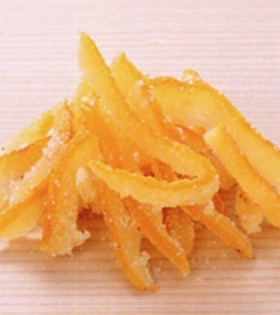
The sugared rind of the yuzu, 柚子, citrus-of, made by Minamoto Ki-chō-an, 源吉兆庵, Origin Lucky-portent-hut, naming it Tokoyo, とこよ, implying eternal, 常世, ever-world. Yuzu is used widely to give a fragrance to the ni-mono, 煮物, boil-thing, served in kai-seki, 懐石, heart-stone, of Chanoyu.
Japan has a multitude of fruits, and of many types including a variety of orange-colored fruits. Oranges are tree fruits. Other abundant tree fruits include apples, peaches, apricots, loquats, etc. Other relished fruits include melons, strawberries. Orange fruits are especially regarded, although not so obviously, for their healthful and medicinal benefits. Certain orange fruits are among the oldest plants native to Japan.
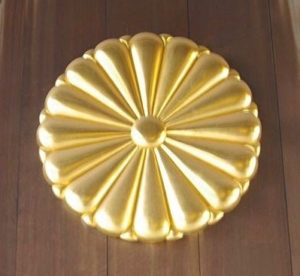
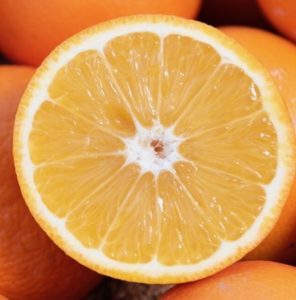
Left: Japanese imperial chrysanthemum crest, Kiku-ka-mon-shō, 菊花紋章, chrysanthemum-flower-crest-design. Daidai, 橙, pictured right, Seville orange, cut in half. The word daidai is wordplay on dai-dai, 代々, generation-generation, and therefore is identified as auspicious. Some citrus trees have both flowers and fruits at the same time.
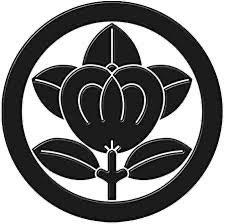
Crest of the Tachibana family, maru-ni tachibana-mon, 丸に橘紋, circle-in citrus-crest, which is an extremely popular motif of the stylized flower of the tree, or it is the fruit(?). The tachibana, 橘, mandarin orange (Citrus tachibana). The word tachibana can be translated stand-flower.
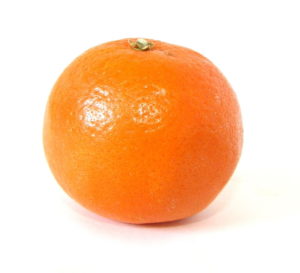
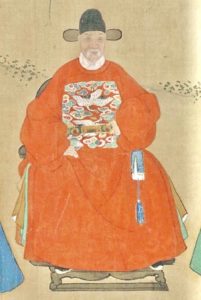
Mandarin: Perhaps via other European languages, ultimately borrowed from Dutch mandarijn or from Portuguese mandarim, both borrowings from Malay menteri, manteri, from Sanskrit mantrin, (Japanese dai-jin, 大臣, great-minister), minister, councilor from Hindi, from mantra, counsel, maxim, mantra, and -in, an agent suffix. The fruit meaning ‘tangerine’ apparently derives from the yellow color of a mandarin’s costume – orange.
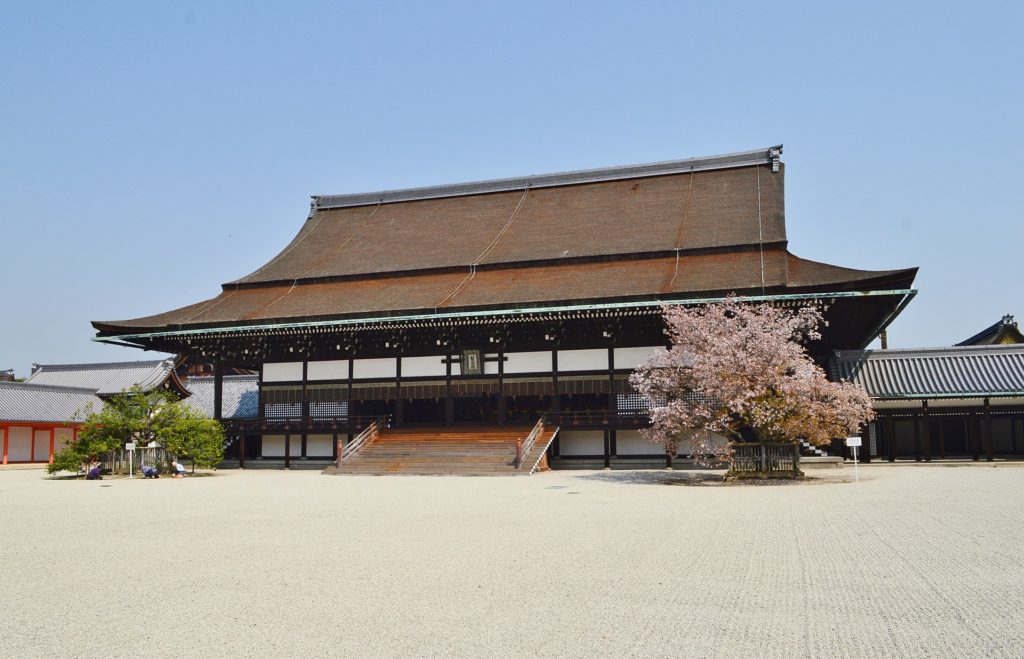
In front of the imperial palace are two trees: to the left in the west is the U-kon no tachibana, 右近橘, right-near mandarin orange, and on the right in the east is the Sakon sakura, 左近の桜, Left-near ’s cherry. The cherry tree produces no fruit, but is praised for its magical flowers. The ‘right’ and ‘left’ are from the perspective of the emperor within the palace.
The tachibana tree does produce fruit, and the fruit is orange like the sun, and in the west would be an orange setting sun the realm of Amida’s Jō-do, 浄土, Pure-land. The east is identified with spring, the autumn is identified with west.
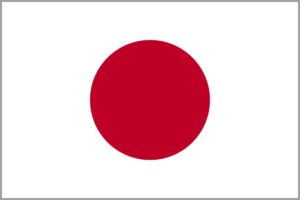

The flag of Japan, hi-no-maru, 日の丸, sun’s-round. Setting sun often turns orange. High in the sky, the sun is blindingly white, and turns red, which is highly auspicious. The emperor is regarded as the child of the sun goddess, Amaterasu. Perhaps the sun is the hō-ju, 宝珠, treasure-jewel.
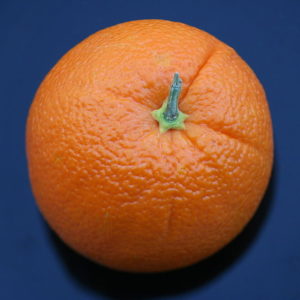
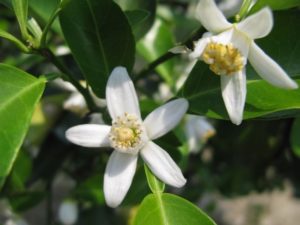
Orange with stem and star-shaped part. The green star-shape is called a receptacle, in Japanese, ka-taku, 花托, flower-entrust; the torus of a flower. The little stem is called a pedicel, in Japanese, shō-ka-hei, 小花柄, small-flower-handle, pedicel, that in botany is a small stalk bearing an individual flower. The form of the kataku often indicates the number of petals of the flower. The tiny pore-like opening on the exocarp / rind of a citrus fruit is called a stoma, which is the opening to an oil gland.
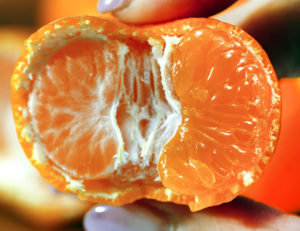
Mi-kan, 蜜柑, honey-citrus, mandarin (esp. the satsuma mandarin (Citrus unshiu)), mandarin orange, tangerine, clementine, satsuma. There are so many varieties that most are easily pealed and loved by children. The name of the tangerine comes from the port of Tangiers, Morocco, from which the fruit was shipped.
The skin of the orange is relatively inedible. The ever-present mikan is peeled before eating the individual sections. Some orange peel is dried, often in the sun, and used in foods for flavor and it beneficial aspects, which is called chin-pi, 陳皮, display-skin. Some oranges are so bitter that they are inedible as well. However, because they were believed to be beneficial, are treated and sweetened and made into jam.
Japanese: skin, hada, 肌. peel, kawa, 皮, pelt, skin, hide, leather, skin, etc. To peel, muku, 剥く, to peel, to skin, to pare, to hull, to strip, bare teeth, etc. Remove, nugu, 脱ぐ, to take off (clothes, shoes, etc.), to undress, escape from, get rid of, be left out, take off, etc.
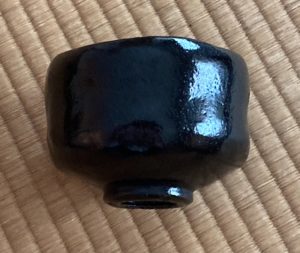
Kuro Raku cha-wan, 黒樂茶碗, black Pleasure tea-bowl, often have a glaze surface with very small pits which are likened to and called mi-kan hada, 蜜柑肌, sweet-orange skin.
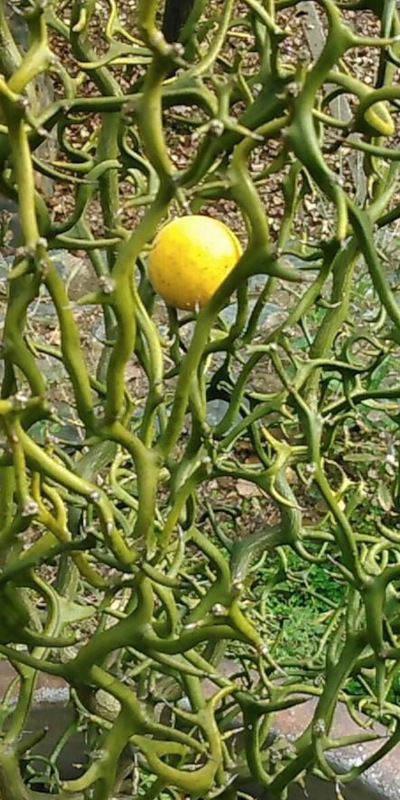
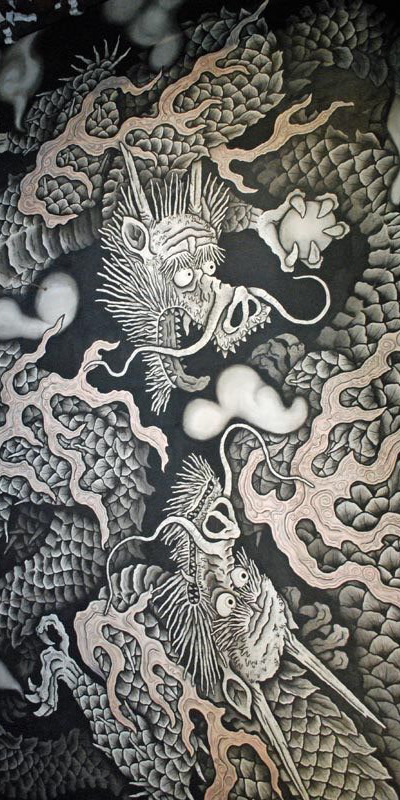
One of the strangest looking plants is the hi-ryū kara-tachi, 飛龍枸橘, flying-dragon wolfberry-mandarin orange: also called un-ryū, 雲龍, cloud-dragon, karatachi. The shrub is almost leafless, has twisted curling branches with alarming, and stout, long thorns. It has few flowers that develop orange fruits, and that appear to be randomly stuck on a thorn. The shrub is often used as a protective hedge. The orange fruit, associated with the dragon, likens it to the hō-ju, 宝珠, treasure-jewel, that the dragon pursues.
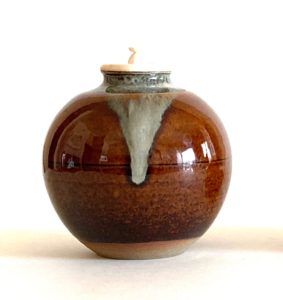
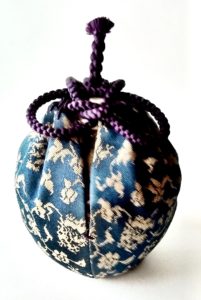
When the chaire has its shifuku removed, the word used for removing is nugu, 脱ぐ, and nui, 脱い, remove. The Kanji is composed of niku or tsuki, 肉 or 月, flesh or moon, and 兑, da, 兌, exchange, one of the hakke of the Eki-kyō, meaning swamp, and identified with the location of chawan.
The shifuku of the chaire is like its clothing or skin. In English, one can ‘peel’ their body, meaning to take off clothing. When the shifuku is removed in a presentation that includes the dai-su, 台子, support-of, or tana, 棚, shelf, a free-standing stand, the shifuku is put on the top shelf which is identified with heaven, ten-ita, 天板, heaven-board. Heaven is the realm of the sun, Tai-Yō, 太陽, great-Yang. In a simple Tea presentation, the shifuku is placed on the floor between the furo and mizusashi, or with the ro, the shifuku is placed to the left of the mizusashi. This location, according to the Ekikyō is identified with the trigram for Heaven, Ken, 乾.
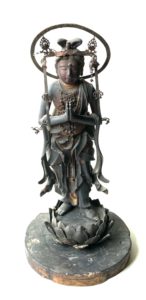
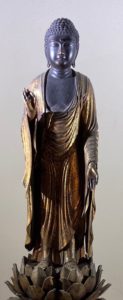
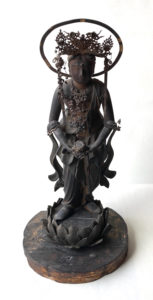
A-mi-da San-zon, 阿弥陀三尊, Praise-increase-steep Three-lords: center – Amida, left – Sei-shi, 勢至, Strength-attain, right – Kan-non, 観音, See-sound.
Kannon is action, she holds the lotus of paradise, and shows that she is action. Seishi has his hands held together is what resembles prayer. He is inactive. Seishi is thought, Kannon is action. Kannon is identified with the right hand, although Kannon is at the left hand of Amida.
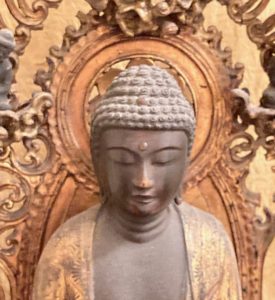
Amida has a halo, kasa, 暈, behind his head and another behind his body. That behind his head is often in the shape of a lotus flower which also resembles the rays of the sun radiating out in the eight directions, like the cross-section of an orange.
The orange represents the sun. The chaire is symbolic of the sun. Amida, Amitabha, in Sanskrit, means ‘infinite light’, and may be identified with the sun.
Amida maybe identified with the bunrin chaire. The shifuku when it has tea in it, has the cord tied so that the uchidome, 打止, hit-stop, is upright at the back, the two ends of the bow at the front on either side. The New Year’s daidai retaining three leaves represents the Amida Sanzon. The upright uchidome may be Amida, the two ends represent Seishi on his right, and Kannon on his left.
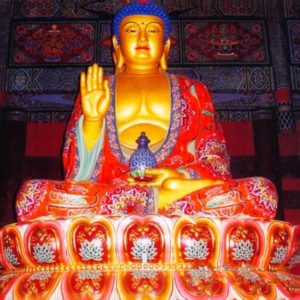
The chest of Amida is exposed to reveal the Mani-pura, マニプラ, chakra, below sternum and above the navel. Miyako no takara, takara no Miyako, 宝の都, treasure ‘s city. Jewels in this area, in Bible, and yoga seat of kundalini, ‘Om mani padme hum’. One of the epithets of A-mi-da, 阿弥陀, Praise-increase-steep, is Kan-ro-ō, 甘露王, Sweet-dew-king, Sanskrit Amrita-raja.

Arrangement of utensils at the beginning of a plain koi-cha ten-mae, 濃茶点前, thick-tea offer-fore: center – mizu-sashi, 水指, water-indicate, represents the Ama-no-kawa, 天の川, Heaven-’s-river, in the north, which is identified with Water according to the I Ching, Eki-kyō, 易経, Change-sutra; right – cha-ire, 茶入, tea-receptacle, represents the Tai-Yō, 太陽, great-Yang, the sun in the east; left – cha-wan, 茶碗, tea-bowl, Tai-In, 太陰, great-Yin, the moon in the west. The three utensils are called the san-kō, 三光, three-radiances. In reality, the mizusashi represents the universe. The universe made manifest is identified with Dai-nichi Nyo-rai, 大日如来, Great-sun Like-become.
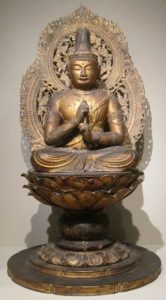
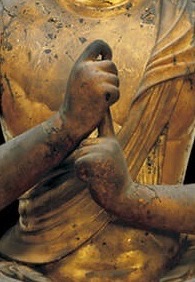
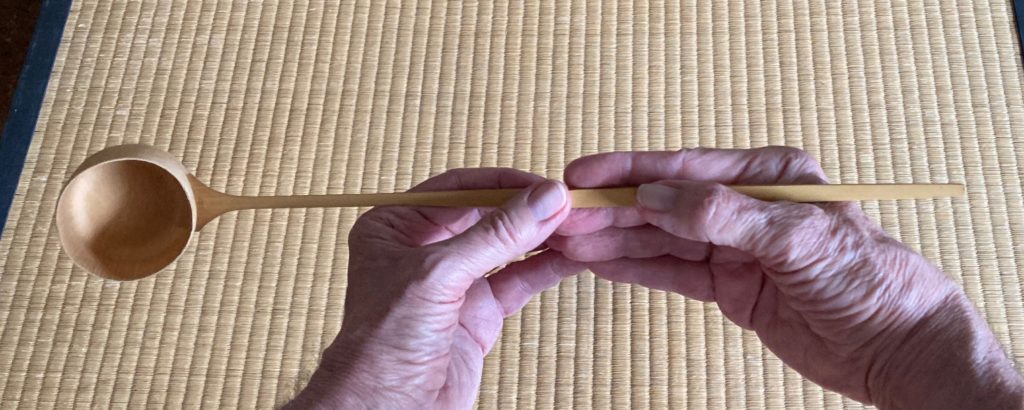
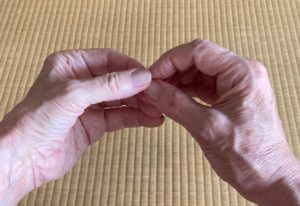
In Chanoyu, the right hand does almost all the action. Hence, when wringing the hands, momi-de, 揉手, wring-hand, the right hand grasps the left thumb. In tsuyu-kiri, 露切, dew-wring, the right index fingers and thumbs touch each other alternating right left. The index fingers continue to touch when making the mudra of Dainichi. Dainichi is the universe and the sun, as his name indicates.
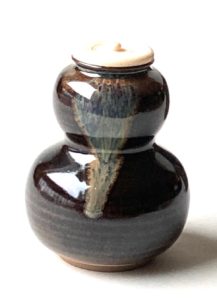
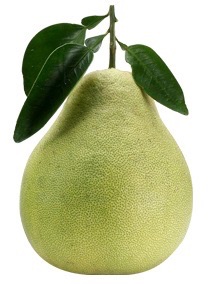
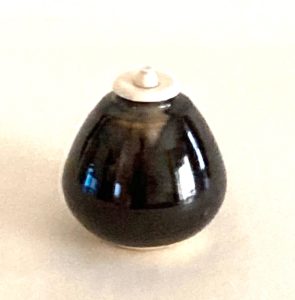
The tea utensils used in Chanoyu are inspired by various aspects of nature. Tea containers are especially influenced by various forms. One of the earliest forms of the cha-ire, 茶入, tea-receptacle, is the hyō-tan, 瓢箪, gourd-basket, the double chamber bottle gourd, which is sacred to Taoism. This form has been the model for other utensils; flower container, water vessels, etc., and as a pictorial design element. The top of the bottle gourd could also be the model for the nasu chaire. The pomelo citrus may also have contributed to the form of the nasu chaire.
